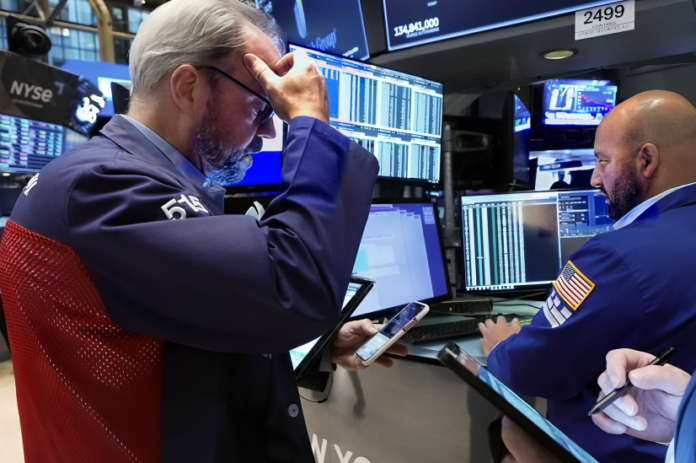Equity bourses worldwide were in a funk on Friday, with share prices taking it on the chin as traders buckled in for the pivotal U.S. employment report that could help seal the deal on the Federal Reserve’s monetary policy plan of attack.
On Wall Street, futures signaled subdued openings for the major indices after a downbeat session in Asia and with European bourses already bleeding red. The s&P 500 and Dow Jones Industrial Average looked adrift ahead of the opening bell in New York.
In Tokyo, the Nikkei 225 got clobbered, plunging 2% as a resurgent yen piled on the hurt for exporters. The broader Topix took a 1.6% haircut too. The rough trading swept across other Asian markets as well, with benchmarks in Sydney, Seoul and Taipei all catching a case of the downdrafts.
That set an inauspicious tone for the Europe’s big board festivities. The regional euroStoxx 600 bluechip gauge sank 1.2% in late morning action across the continent. In Frankfurt, the DAX slipped 1.4% while Paris’ CAC 40 fell 1.3%. Even Britain’s shares joined the party poopers as the FTSE 100 retreated 1%.
The hair-raising sell-off came as investors psyched themselves up for the U.S. Labor Department’s hugely scrutinized monthly employment data drop later in the global day. The consensus among economists is that around 240,000 new jobs got added to U.S. payrolls in March, marking a cooldown from February’s red-hot 311,000 gain.
But any upside stunner on that jobs number could throw a serious monkeywrench into the works for markets currently betting that the Fed’s most aggressive round of interest rate hikes in decades is drawing to a close. Central bank bigwigs have made it crystal clear that more rate increases are a bet-the-farm prospect as they try to hang tough on runaway inflation.
“The market is on tenterhooks looking for any signs that red-hot labor demand is losing some serious steam in line with the economy’s broader downshift,” said Ian Shepherdson at Pantheon Macroeconomics. “A number that blows away the 240,000 forecast would force a drastic rethink of where the Fed’s rate-hiking cycle is headed.”
Persistently tight employment conditions have been general-issue numero uno for the Fed’s rate-setters. While the jobless rate has inched up to 3.6% in recent months, it remains in nosebleed territory near half-century lows, presenting a huge hurdle to getting prices back under control.
Average hourly earnings are still climbing at an eye-watering 4.5%-plus annual clip as well, keeping a firm grip on consumer prices even as the overall growth engine has been pumping fumes over the past year.
Traders got a fresh gut-punch this week on just how much more heavy lifting may still lie ahead for the Fed when a gauge of U.S. manufacturing activity rebounded back into expansion mode in March. That raised a huge red flag that the rate increases so far haven’t fully drained demand from the system yet.
The upshot is that money markets have been scrambling to price in the Fed’s benchmark policy rate peaking well north of 5.25% this year, compared to the 5% high-water mark expected just months ago. On Thursday, Fed governor Christopher Waller poured some more gas on those nascent fears, saying he favors more rate hikes to apply “meaningful” downward pressure on inflation.
In the government bond pits on Friday, the yield on the 10-year U.S. Treasury note ticked higher to around 3.34%, extending a climb over the past week. The rising yields, which move inversely to prices, underscored how much economic ache and higher borrowing costs markets anticipate lie ahead.
On the geopolitical front, traders were also keeping a wary eye trained on fresh missile strikes from Iran targeting Kurdish separatist bases in northern Iraq. Brent crude, the global oil benchmark, edged up 0.1% to $90.71 a barrel amid the broader Middle East tensions.
Meanwhile, a Reuters survey showed analysts have been rapidly slashing their estimates for how the skyrocketing corporate profit party will play out across Asia this year, beyond bright spots like India and Indonesia. Earnings at the region’s biggest firms are now expected to grow just 3.8% in 2023, sharply lower than the almost 8% increase projected in January.
Even so, some market mavens argued that the longer-run outlook for Asian equities remains solid as China steadily reopens following its draconian “zero-Covid” policy that hammered growth. A full-fledged revival in the world’s second-biggest economy could be a booster shot for exporters in nations like Japan and South Korea.
“Japan is a prime beneficiary of the U.S. avoiding recession, with exporters spearheading the equity charge,” analysts at Societe Generale wrote on Friday. They added that Chinese shares and the region’s equity bourses are poised for resilience this month.
Others were decidedly more circumspect ahead of the jobs data, underscoring how much hinges on the Fed’s next gambit in trying to pull off a fabled “soft landing” for the economy.
“There are already clear signs of economic cooling,” said Tan Jing Yi at Mizuho Bank in Singapore. “But entrenched pressures for relentless wage gains persist.”






















